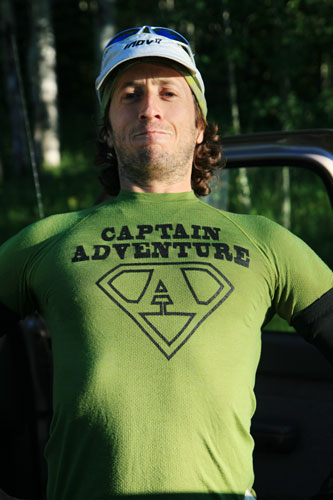
TMF stands for “Too Much Fun” but these trips are also known as sufferfests. Andy only gets one big trip every year and he tries to make it so extreme that he is happy to be back in North Dakota for as long as possible. Then he starts dreaming up the next TMF. When I hear the plans for the next trip, I always feel a bit overwhelmed, but I haven't been arrested or killed yet, so I agree to go and it is always one of the most memorable trips of the year. This year I even followed most of Andy's workout plan to get in shape for it. He calls it the 3 hour a week workout, but I thought of it as “get fit or die trying”. I didn't die and I did improve my fitness a lot. I also had the advantage of being able to play in the mountains for a bit before the trip, so I was acclimated. I needed every edge I could get to try to keep up with a cast of serious adventure racers and fitness freaks, especially as the “old man” of the group. The cast of Yogaslacker characters for this trip were myself, Tom Grundy, a long time itinerant climber, Daniel Staudigel, the youngest and largest member of the Yogaslacker adventure racing team. Andy Magness, the mastermind and training guru, his twin brother Jason – another of the intrepid adventure racers, and his fiance Chelsey Gribbon- the smallest (and possibly the toughest) Yogaslacker. The team was rounded out by Sam Salwei, who manages to maintain 8 pack abs with a diet rich (and I mean Bill Gates rich) in whole milk and ice cream while living in the famous Peace Love Car, a heavily modified Ford Festiva. The fact that he is always busy with something might help.
 |
|---|
The Too Much Fun Expedition for 2010 was in the Wind River Range of Wyoming. Past Expeditions have been in Montana and Washington, and the expedition that opened our eyes to the possibilities of combining multiple modes of travel and adventure was in the Northwest Territories of Canada. The main idea is for a group of adventurers to head into the wilderness with barely enough equipment to get through most of a grueling schedule including multiple modes of travel that aren't usually paired together (like skiing and boating last year). This year it was hiking, rock climbing, mountaineering, and packrafting. Usually the schedule is a little too ambitious and something has to be dropped before the trip is over.
We assembled in Pinedale, Wyoming and sorted gear and food in a city park. Of course we had a bunch of new gear we hadn't tried or even seen before the trip. For example we had new Inov-8 roclite 288 GTX hiking boots for this trip, and they worked excellently. Andy had modified some tiny OR LightHaven shelters for us to sleep in, they worked (sort of). Finally all of the gear and food were ready and we headed out to camp for the night.
Luckily it was cold the night before we left, so the next morning we decided that just maybe taking two 50 degree rated sleeping bags (for the 6 of us) would be worth the weight. (previously Andy thought that it made more sense to just wear our clothes and make do). This was a very good decision.
After last minute packing and delays, the gang took off running up the trail. I decided that was too ridiculous and kept to a fast walk. After a few quick miles we turned and waded across a creek and thrashed around looking for the trail, then found it and headed up a long steep hill in a forest fire burn scar. This uphill was rather brutal for the 2 of us carrying the large gust packs (with a lot more weight than the others). We had the uneven sized packs so we could shuffle gear around to allow us to do rock climbs with all our gear with us. But that was no consolation for Andy and I's burning quads. Eventually we emerged onto a high plateau with stunning views of the high peaks we were heading towards. We saw a surprising number of people this day including hikers, fishermen, and horsepackers.
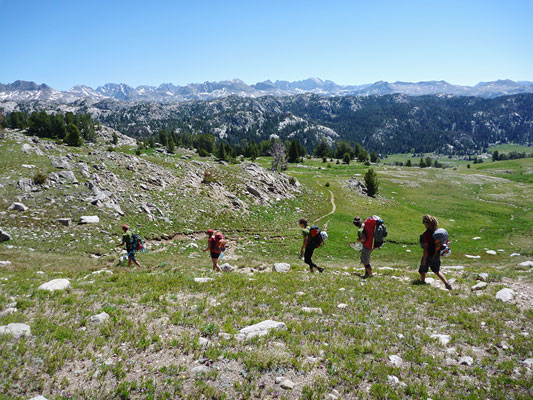 |
|---|
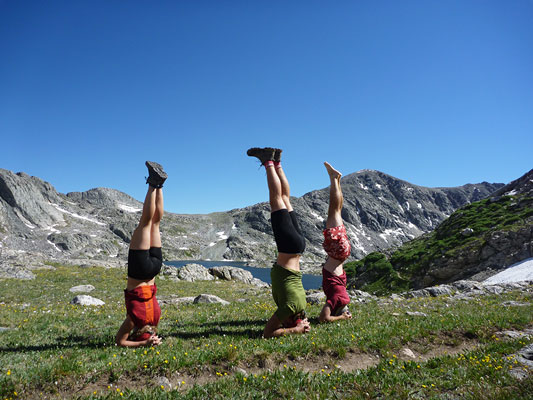 |
|---|
After many beautiful high country trail miles we cut up a drainage to a small flat area below Arrowhead Peak. The dihedral splitting the face we planned to climb looked awesome. We ate our now “cooked” (really just soaked in cold water) rehydrated Alpine Aire meals (surprisingly good, although I am sure with hot water they would be even better) and enjoyed the last of the sun. Once we were in shadow, the temperature dropped rapidly. We crawled into our shelters for the night before it even got dark. Unfortunately our sleep wasn't particularly deep. Mostly this was because of the close quarters (the LightHaven shelters have 1.5 meter sides, but they are sloped, so all of the space is not useable). One advantage of being packed in like sardines was that it was warm – at least for the taller people in the middle. It seemed that when any one of us shifted, it woke the rest, and we all shifted to a new position (we couldn't really all be flat on our backs at once).
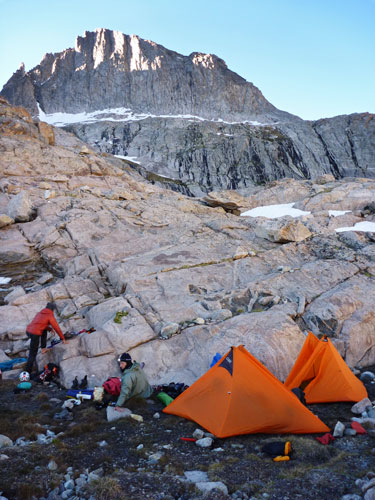 |
|---|
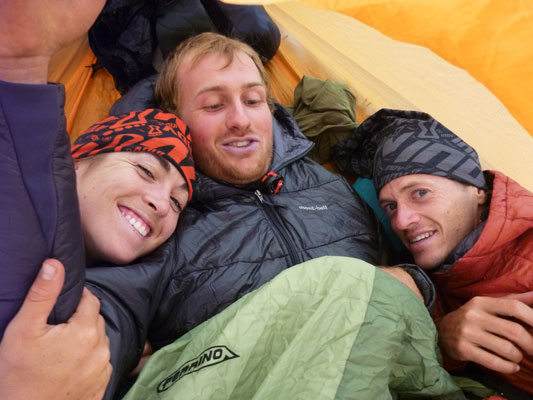 |
|---|
We got up fairly early excited to get on Arrowhead peak. We decided to shuttle some gear up by the descent to save us from having to do technical rock climbing with all of our stuff (mainly the boats and 5 days worth of food). There were a few clouds blowing in from the west, so we decided to keep our rain gear for the climb. 3 people headed off up the hill leaving the other 3 of us to find the base of the climb and get started.
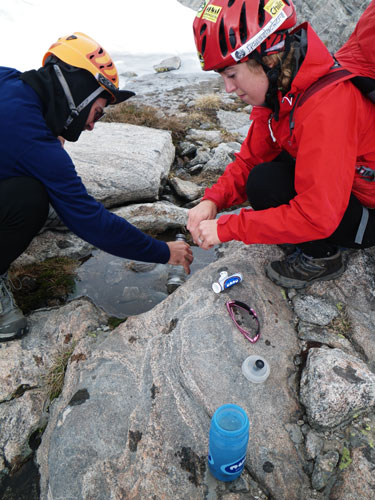 |
|---|
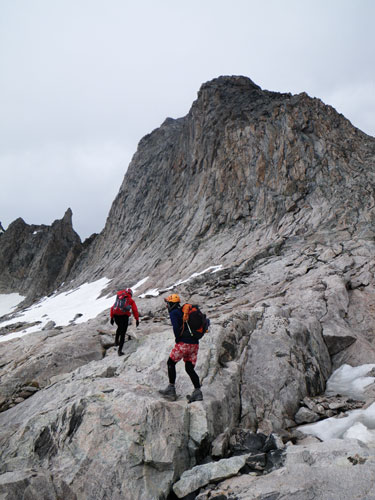 |
|---|
We scrambled up the last of the snowslope and started trying to decide which dihedral was the obvious one. After a fair bit of debate (at least in my mind if not out loud), we decided it must be farther around a small buttress. The scrambling to get there was exciting (low 5th class - easily handled by the Inov-8 288s ). This dihedral looked much more obvious (and more likely the 5.7 or so we were expecting). Out came the rope and gear and I got set up for the first pitch. Meanwhile, the clouds thickened, and it started to rain. boo. At first it seemed like it might blow over quickly, so we hunkered down and waited. The rain started to get stronger, and then we could see that more rain was on the way. By now the rest of the crew had returned, so we rappeled and downclimbed back and sought shelter under a barely overhanging rock. As the wind and rain picked up it became clear that we wouldn't be climbing that morning (the route became a waterfall). We also realized that the rock we were “under” wasn't acceptable shelter, so we headed back to go get more of our warm gear.
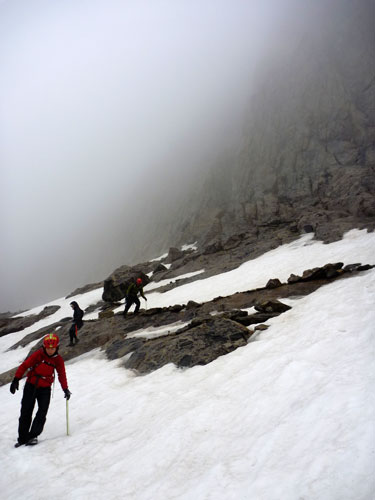 |
|---|
Unfortunately, this is when the lightning and thunder started, and we decided heading up to a high ridge was a very bad idea. We headed down lower and found a large flat rock that we all could barely crawl under in some fashion. Although drier and somewhat sheltered from the wind, it was by no means comfortable or warm. I only had shorts and leg warmers on my legs, although my upper body was reasonably warm in a therma-wrap jacket and rain coat. We shivered, laughed, and shared what food we had while waiting for the storm to move on. When it did, 3 of us headed up the steeper snow to get the packs, while the rest headed up a more gradual slope to where we hoped to be able to cross the ridge and descend the far side. At least the rain had softened up the snow enough so that it wasn't too sketchy heading up the steep snow field with only 2 ice axes and no crampons. The steep uphill hike also helped warm us up, and dry out my legs a bit.
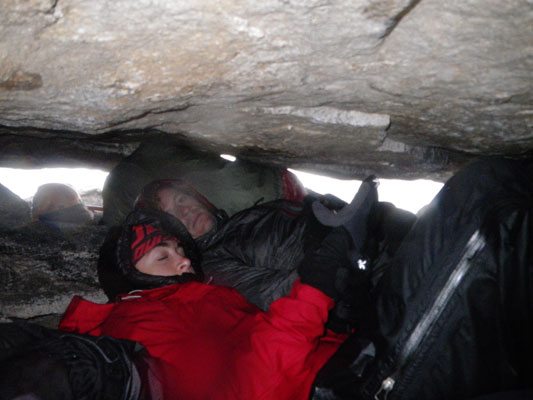 |
|---|
When we got to the packs, there was a brief break in the clouds and a minute of glorious sun. Andy thought maybe we should go back to do the climb, but the fact that the east face we had planned to descend was a large waterfall helped us convince him that it was a poor choice (and the thick clouds blowing back in didn't hurt the decision either). We traversed along the ridge to meet up with the others and prepare for the next hurdle. It looked like the couloir we would be climbing down was very steep (they always look steep from the top, so it wasn't really all that bad, maybe 45 or 50 degrees for the first bit, then decreasing from there). We started down gingerly front pointing and burying the handles of our “ice” axes. Once the angle eased, we turned around and started boot plunging down and across the large bowl of snow and rock towards Knapsack Pass. The weather was very unsettled through this section with some brief sun, clouds, whiteout, and rain.
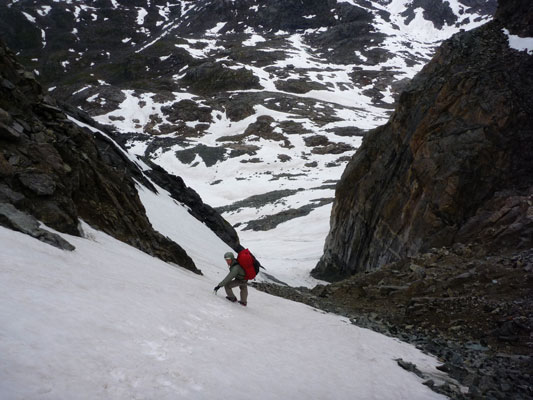 |
|---|
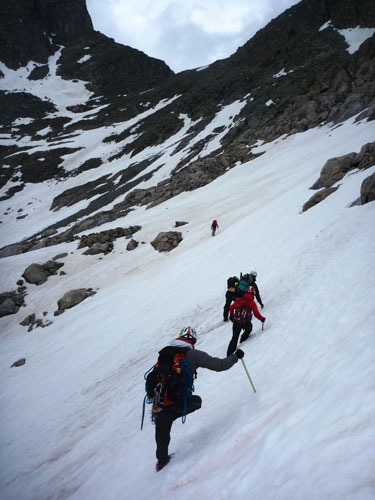 |
|---|
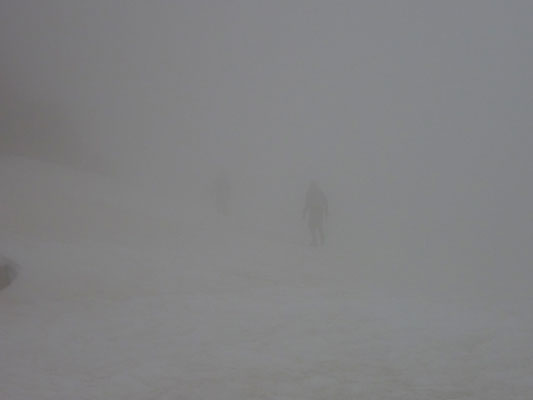 |
|---|
From the pass we had to drop down a steep snowfield into Titcomb Basin. Some opted to go down the steep snow, others downclimbed on the rocks for the first part. Then we were able to glissade down quite a ways. When we looked back, the top of the snow looked impossibly steep. We managed to get a little bit of sunlight at camp before the sun descended below the steep walls of the basin. The views up at Mt Helen were quite impressive, dominated by the pyramid shaped Tower 1.
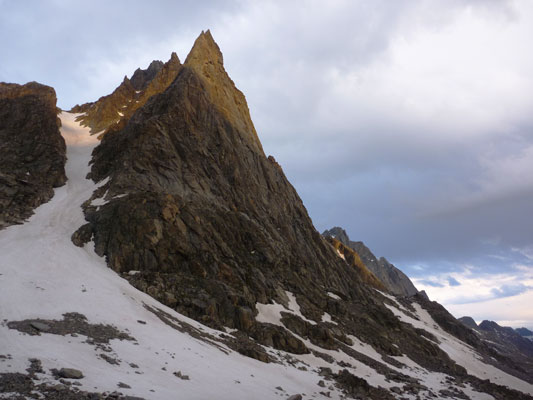 |
|---|
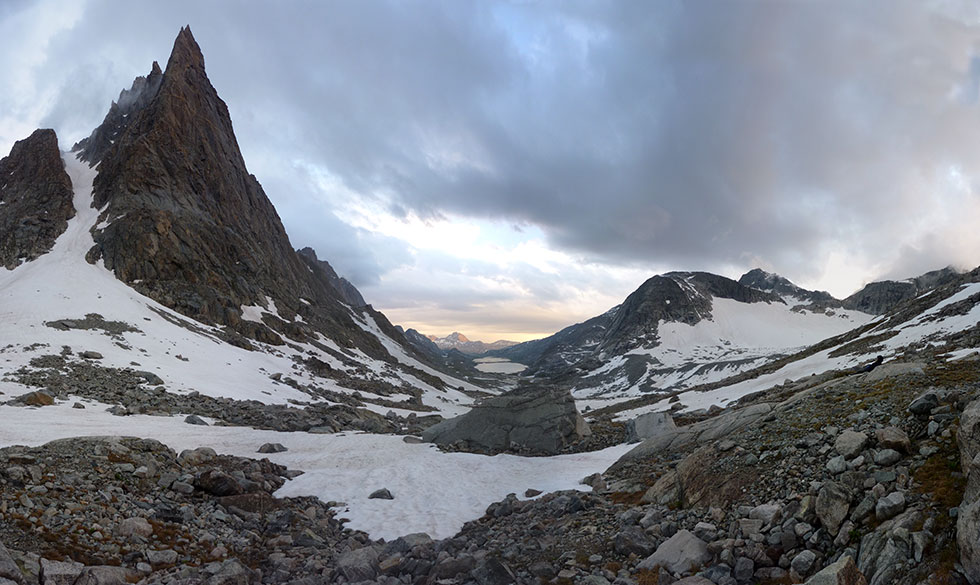 |
|---|
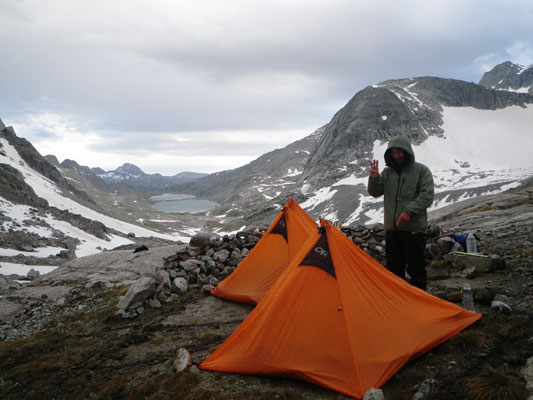 |
|---|
That night the sleeping system got another good workout when a long storm hit complete with hail, rain, wind, and lightning. With everything zipped up tight, we were warm and relatively dry (the wind and hail sprayed the condensation off the interior onto us, but we stayed dry inside our clothes and under the sleeping bag). I was awakened a few times in a horrendous manner with fat drops of icy water that landed in my eye or went down my neck. It was a good thing we had trenched around the uphill side of our shelter. We also discovered that with everything sealed up the level of CO2 rose enough to cause increased rate of breathing (at least that is what we think). Chelsey was most susceptible to the feeling of claustrophobia with wet waterproof nylon pressed against her face. Although our “suffer-light” sleep system worked, I don't think any of us would really recommend it.
To be continued.... in Part II
link to the spot track from this trip
The spot track is nice, but it sure didn't get the start and end right (by the lake to the southwest).